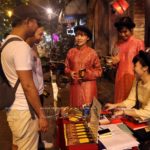The Vietnamese Permanent Delegation to UNESCO, in collaboration with the People’s Committee of Bac Ninh province, the Vietnamese Embassy in France, and the Vietnamese Cultural Centre in France, organized an event commemorating the 15th anniversary of UNESCO recognizing Bac Ninh Quan Ho singing as Intangible Cultural Heritage.
Nearly 200 participants, including ambassadors to UNESCO, French agency representatives, and members of Vietnamese associations in France, attended this cultural celebration.
The event showcased two unique art forms of Kinh Bac: Quan Ho singing and Dong Ho painting. Participants had the opportunity to immerse themselves in these traditional art forms and learn about their significance.
Kinh Bac, historically comprising Bac Giang province and parts of Hanoi, is a region steeped in legend and considered the cradle of the Dai Viet civilization. It occupies a central position in the Red River Delta, endowed with fertile land and picturesque landscapes, fostering economic and cultural exchanges.
With roots tracing back to before Christ, Kinh Bac is one of the birthplaces of the wet rice civilization and the foundation of the Great Viet civilization. It is renowned for its vibrant folk festivals, particularly Quan Ho singing, which blends music, lyrics, and costumes, reflecting the distinct culture of the region.
Ambassador Nguyen Thi Van Anh, Permanent Representative of Vietnam to UNESCO, emphasized Vietnam’s commitment to safeguarding intangible cultural heritage and promoting cultural values aligned with sustainable development. She highlighted Vietnam’s active role in the Intergovernmental Committee for the Safeguarding of Intangible Cultural Heritage, working closely with other member countries to uphold the convention.
Mysterious Cham Towers in Binh Dinh
Despite the impacts of time, the mysterious Cham towers that are one thousand years old have remained in the windy and sunny land of Binh Dinh in the Central region as vivid evidence of the flourishing period of the ancient Champa Kingdom in the 10th-15th centuries.








